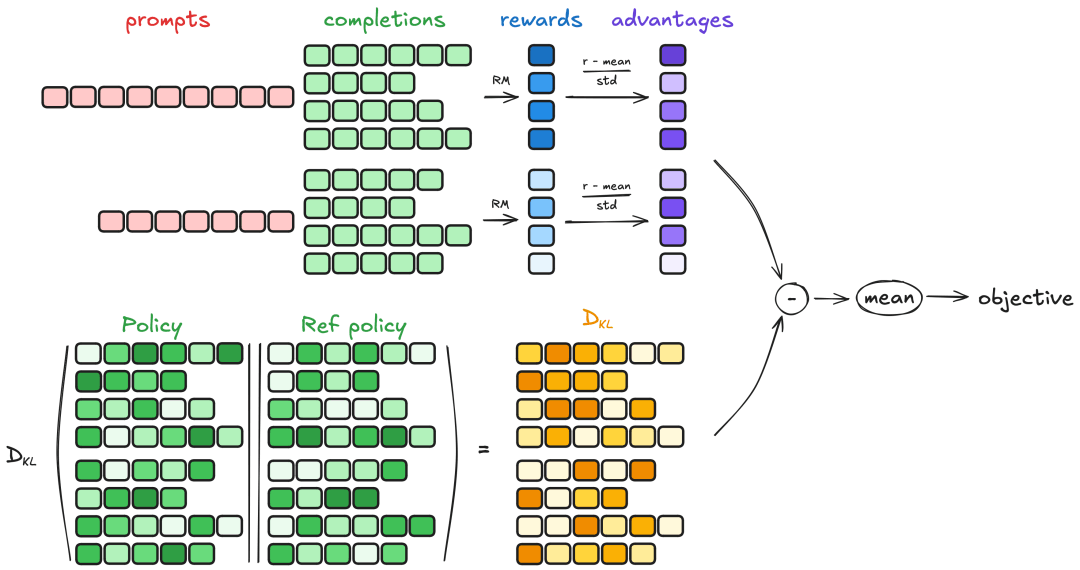0元!使用魔搭免费算力,基于Qwen基座模型,复现DeepSeek-R1
近期,随着DeepSeek-R1爆火,学术界掀起一股复现DeepSeek-R1的浪潮,李飞飞等斯坦福大学和华盛顿大学的研究人员以不到50美元的云计算费用,成功训练出了一个名为s1的人工智能推理模型。
01.引言
近期,随着DeepSeek-R1爆火,学术界掀起一股复现DeepSeek-R1的浪潮,李飞飞等斯坦福大学和华盛顿大学的研究人员以不到50美元的云计算费用,成功训练出了一个名为s1的人工智能推理模型。该模型在数学和编码能力测试中的表现,宣称与OpenAI的O1和DeepSeek的R1等尖端推理模型不相上下。
今天,我们使用魔搭社区的免费力算,基于Qwen基础,使用OpenAI的gsm8k数据集,基于Qwen基础模型,复现类似DeepSeek-R1的推理模型。
算力
魔搭社区免费GPU算力:https://modelscope.cn/my/mynotebook
基座模型
Qwen2.5-0.5B-Instruct:https://modelscope.cn/models/Qwen/Qwen2.5-0.5B-Instruct
咖啡
gsm8k:https://modelscope.cn/datasets/modelscope/gsm8k
训练工具
TRL:https://huggingface.co/docs/trl/main/en/grpo_trainer
笔记本分享链接
https://modelscope.cn/notebook/share/ipynb/c4d8363a/Qwen-GRPO.ipynb
02.新技术
本文使用 TRL 的 GRPO Trainer 来训练 Qwen 基础模型(注,本文示例使用 Qwen2.5-0.5B 模型作为示例,但生产场景建议使用 3B 及以上模型),如邵志宏等人论文《DeepSeekMath:在开放语言模型中突破数学推理的极限》中所述。
该论文的摘要如下:
第一步:安装依赖
其他的依赖在ModelScope的笔记本镜像预装好,本次只需要升级vllm和trl到最新版本,安装后请重启ipynb环境。
!pip install vllm -U
!pip install trl -U第二步:定义提示的结构,需要包含推理标签
import re
import torch
from modelscope.msdatasets import MsDataset
from modelscope import AutoTokenizer, AutoModelForCausalLM
from trl import GRPOConfig, GRPOTrainer
# Load and prep dataset
SYSTEM_PROMPT = """
Respond in the following format:
<reasoning>
...
</reasoning>
<answer>
...
</answer>
"""
XML_COT_FORMAT = """\
<reasoning>
{reasoning}
</reasoning>
<answer>
{answer}
</answer>
"""第三步:导入gsm8k数据集并重构它以适应对话提示的结构
def extract_xml_answer(text: str) -> str:
answer = text.split("<answer>")[-1]
answer = answer.split("</answer>")[0]
return answer.strip()
def extract_hash_answer(text: str) -> str | None:
if "####" not in text:
return None
return text.split("####")[1].strip()
# uncomment middle messages for 1-shot prompting
def get_gsm8k_questions(split = "train") -> MsDataset:
data = MsDataset.load('modelscope/gsm8k', subset_name='main', split=split)
data = data.map(lambda x: { # type: ignore
'prompt': [
{'role': 'system', 'content': SYSTEM_PROMPT},
{'role': 'user', 'content': x['question']}
],
'answer': extract_hash_answer(x['answer'])
}) # type: ignore
return data # type: ignore
dataset = get_gsm8k_questions()第四步:使用自定义的是Rewarding函数。其中最“正确性”函数 Correctness_reward_func,它充当验证器(比较模型完成情况与答案)。其他三个是格式化函数,论文针对gsm8k数学场景,验证结果是否为int重要类型输出,是否带推理标签等。
# Reward functions
def correctness_reward_func(prompts, completions, answer, **kwargs) -> list[float]:
responses = [completion[0]['content'] for completion in completions]
q = prompts[0][-1]['content']
extracted_responses = [extract_xml_answer(r) for r in responses]
print('-'*20, f"Question:\n{q}", f"\nAnswer:\n{answer[0]}", f"\nResponse:\n{responses[0]}", f"\nExtracted:\n{extracted_responses[0]}")
return [2.0 if r == a else 0.0 for r, a in zip(extracted_responses, answer)]
def int_reward_func(completions, **kwargs) -> list[float]:
responses = [completion[0]['content'] for completion in completions]
extracted_responses = [extract_xml_answer(r) for r in responses]
return [0.5 if r.isdigit() else 0.0 for r in extracted_responses]
def strict_format_reward_func(completions, **kwargs) -> list[float]:
"""Reward function that checks if the completion has a specific format."""
pattern = r"^<reasoning>\n.*?\n</reasoning>\n<answer>\n.*?\n</answer>\n$"
responses = [completion[0]["content"] for completion in completions]
matches = [re.match(pattern, r) for r in responses]
return [0.5 if match else 0.0 for match in matches]
def soft_format_reward_func(completions, **kwargs) -> list[float]:
"""Reward function that checks if the completion has a specific format."""
pattern = r"<reasoning>.*?</reasoning>\s*<answer>.*?</answer>"
responses = [completion[0]["content"] for completion in completions]
matches = [re.match(pattern, r) for r in responses]
return [0.5 if match else 0.0 for match in matches]
def count_xml(text) -> float:
count = 0.0
if text.count("<reasoning>\n") == 1:
count += 0.125
if text.count("\n</reasoning>\n") == 1:
count += 0.125
if text.count("\n<answer>\n") == 1:
count += 0.125
count -= len(text.split("\n</answer>\n")[-1])*0.001
if text.count("\n</answer>") == 1:
count += 0.125
count -= (len(text.split("\n</answer>")[-1]) - 1)*0.001
return count
def xmlcount_reward_func(completions, **kwargs) -> list[float]:
contents = [completion[0]["content"] for completion in completions]
return [count_xml(c) for c in contents]原理参考:GRPO 是一种在线学习算法,这意味着它通过在训练期间使用训练模型本身生成的数据来迭代改进。GRPO 背后的直觉是最大化生成完成的优势,同时确保模型保持逼近参考策略。要了解 GRPO 的工作原理,可以将其分割为四个主要步骤:生成、计算优势、估计 KL 散度和计算损失。

添加图片注释,不超过 140 字(可选)
图片来源:https://huggingface.co/docs/trl/main/en/grpo_trainer
第五步:设置训练参数,本文是在22G显存力上运行,业务场景计算上建议使用两张卡,一张专门用于vLLM推理,另一张训练用于。
model_name = "Qwen/Qwen2.5-0.5B-Instruct"
output_dir="outputs/Qwen-0.5B-GRPO"
run_name="Qwen-0.5B-GRPO-gsm8k"
training_args = GRPOConfig(
output_dir=output_dir,
run_name=run_name,
learning_rate=5e-6,
adam_beta1 = 0.9,
adam_beta2 = 0.99,
weight_decay = 0.1,
warmup_ratio = 0.1,
lr_scheduler_type='cosine',
logging_steps=1,
bf16=True,
per_device_train_batch_size=1,
gradient_accumulation_steps=4,
num_generations=8,
max_prompt_length=256,
max_completion_length=200,
num_train_epochs=1,
save_steps=100,
max_grad_norm=0.1,
log_on_each_node=False,
use_vllm=True,
vllm_gpu_memory_utilization=.2,
vllm_device="cuda:0",
report_to="none" #I'm disabling Wandb.
)
model = AutoModelForCausalLM.from_pretrained(
model_name,
torch_dtype=torch.bfloat16,
device_map=None
).to("cuda")
tokenizer = AutoTokenizer.from_pretrained(model_name)
tokenizer.pad_token = tokenizer.eos_token第六步:构建训练器,开始训练
trainer = GRPOTrainer(
model=model,
processing_class=tokenizer,
reward_funcs=[
xmlcount_reward_func,
soft_format_reward_func,
strict_format_reward_func,
int_reward_func,
correctness_reward_func],
args=training_args,
train_dataset=dataset,
#peft_config=peft_config
)
trainer.train()第七步:推理效果验证
from modelscope import AutoModelForCausalLM, AutoTokenizer
model_name = "/mnt/workspace/outputs/Qwen-0.5B-GRPO/checkpoint-1868"
model = AutoModelForCausalLM.from_pretrained(
model_name,
torch_dtype="auto",
device_map="auto"
)
tokenizer = AutoTokenizer.from_pretrained(model_name)
prompt = "Xiao Ming bought 4 apples, ate 1, and gave 1 to his sister. How many apples were left?"
messages = [
{"role": "system", "content": SYSTEM_PROMPT},
{"role": "user", "content": prompt}
]
text = tokenizer.apply_chat_template(
messages,
tokenize=False,
add_generation_prompt=True
)
model_inputs = tokenizer([text], return_tensors="pt").to(model.device)
generated_ids = model.generate(
**model_inputs,
max_new_tokens=256
)
generated_ids = [
output_ids[len(input_ids):] for input_ids, output_ids in zip(model_inputs.input_ids, generated_ids)
]
response = tokenizer.batch_decode(generated_ids, skip_special_tokens=True)[0]
print(response)<理由>
最初小明有4个苹果,吃掉1个苹果后,剩下4-1=3个苹果,然后他把1个苹果给了妹妹,剩下3-1=2个苹果。
</推理>
<答案>
2
</答案>
03.展望
我们可以看到,我们的推理模型已经有了一定的效果——虽然它只是一个例子,肯定还会有一些错误,因为我们只训练了一个很小的数据集——如果我们延长序列长度,选择更坚固的基础模型,如Qwen2.5-32B并训练更长时间,模型的效果会更好。
点击链接,即可领取免费算力~
更多推荐
 已为社区贡献649条内容
已为社区贡献649条内容










所有评论(0)